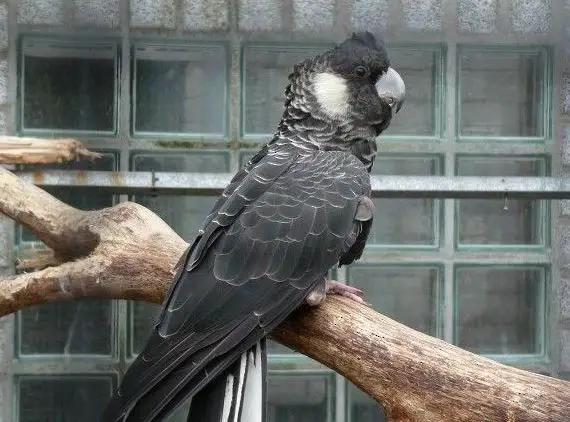
Baudin’s black-cockatoo Calyptorhynchus baud init Scientific name definitions, Identification:55–60 cm; 540–790 g, culmen 53 mm. Body plumage dull black with buff margins to the feathers, greyish white patch on ear-coverts
Baudin’s black cockatoo tail shows a broad subterminal white panel, with central two feathers all black; eye dark brown, feet grey-brown. Sexes are similar, but periophthalmic skin is pink in males and dark grey in female
Bill grey-black in male and bone-coloured in female; female has larger ear patch. Immature resembles female.
Systematics History
Closely related to Z. funerea and Z. latirostris. Long considered conspecific with latter, but currently treated as separate species because ecology quite different, and a bill significantly longer;
difficulty in field identification, compounded by a long history of conspecific treatment, has led to uncertainty regarding limits of range in the area of overlap, and to the publication of some inaccurate maps.
Present Baudin’s Black-Cockatoo species have also, on occasion, been lumped in Z. funerea. Confusion over the bill size of the specimen used in the original description led to the proposal of race tenuirostris, but this name is shown to be synonymous with baud init. Monotypic.
Subspecies
Monotypic.
Distribution
Forested extreme SW Western Australia in the region bounded by Perth, Albany, and Margaret R; breeds in S of this range.
Habitat

Breeds in forests of jarrah (Eucalyptus marginata) and karri (E. diversicolor), in zones of higher rainfall, averaging over 750 mm per year. Less frequently found in other types of woodlands, partly cleared farmlands, and urban areas including roadside trees and house gardens.
Movement
After breeding, family groups tend to coalesce and form larger flocks that may forage nomadically N and E beyond their breeding distribution.
The bulk of the population largely vacates in autumn the coldest parts of the range (2). Sometimes feeds in mixed flocks with Z. latirostris.
Diet and Foraging
The long upper mandible enables the extraction of large seeds from the large fruit of marri (Eucalyptus calophylla); the fruit is held on the foot
during seed extraction. Also eats seeds of a variety of native plants (Banksia, Dryandra), and insect larvae. It forages at all levels of the forest from the canopy to the ground, often feeding in the understorey on proteaceous trees and shrubs, especially Banksia, and in orchards both in trees and on dropped or fallen fruit on the ground.
Removes seeds from orchard apples in the same way as seeds are extracted from marri, and in consequence species is sometimes regarded as a pest.
Baudin’s black cockatoo call
The commonest call, typically given in flight, is a rather high-pitched slurred squealing “kweEE-ah”. When perched, vocabulary is more diverse and elaborate, with most notes having a similar tonal quality to flight calls.
Baudin’s black cockatoo Breeding
Monogamous, probably mates for life; the pair stay together all year round except when the female is incubating and brooding; both adults play a part in selecting the nest hollow, but only the female is responsible for renovation and preparing the hollow for breeding.
Males recorded making the breeding call and displaying to females in most months, but more frequently in Aug–Oct. Laying Aug–Jan.
Baudin’s Black-Cockatoo Nest is a bed of woodchips in a hollow, high in either jarrah or a karri tree. 1–2 eggs; in captivity, incubation by female 28 days; chick has yellow or white down;
a nestling period of 16 weeks, in captivity, seems overlong, and realistic figure is probably similar to that of Z. latirostris. Usually only one young survives to fledge.
Conservation Status

ENDANGERED. CITES II. Previously considered Vulnerable. Currently still numerous, but the concern is expressed over continued frequent burning of forests and clear-felling (see Family Text ), especially in conjunction with long time span before a seedling eucalypt is likely to have a hollow usable for cockatoos.
Over a quarter of its original habitat has been cleared. Total population was estimated at 5000–25,000 birds in 1977. Orchardists still shoot marauding cockatoos under permit, but examination of the problem suggests that they would probably be economically better satisfied if they netted their trees.




















